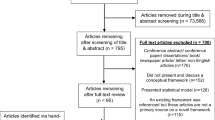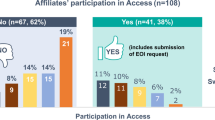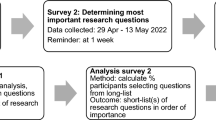Abstract
Objectives To evaluate the views of Australian pharmacists on expanded pharmacist prescribing roles and identify important drivers and barriers to its implementation. Setting Pharmacists in Australia. Method Data were collected using a self-administered questionnaire distributed nationally to a random sample of pharmacists either directly, or in the case of one state, via community pharmacies. One-way ANOVA and ϰ2 testing were used to identify significant associations. Factor analysis was conducted to pool variables and the derived factors were subjected to regression analysis. Mainoutcomemeasures Perceptions of Australian pharmacists on expanded prescribing and the relationships between variables derived. Results A total of 2592 questionnaires were distributed and a response rate of 40.4% was achieved (n = 1049). Of the respondents 83.9% strongly agreed/agreed to an expanded prescribing role for pharmacists and 97.1% reported they would need further training. Of the respondents 896 agreed that pharmacists should engage in supplementary, independent prescribing or both. Of these 69.1% preferred only supplementary prescribing, 3.3% independent prescribing and 27.4% both models. Both models were found to be positive predictors of expanding pharmaceutical services through prescribing (P < 0.001) with supplementary prescribing showing a stronger association (β = 0.52 vs. β = 0.18). Pharmacists’ opinion based on their current perceptions of their clients was an important predictor in expanding pharmaceutical services through prescribing (P = 0.005). Inadequate training in patient assessment, diagnosis and monitoring were the strongest barriers to expanded pharmacist prescribing (P < 0.001). Conclusions The majority of Australian pharmacists supported an expanded pharmacist prescribing role. Support for supplementary was stronger than independent prescribing. Pharmacists acknowledged that they would need further training to perform such roles.

Similar content being viewed by others
References
Department of Health; Pharmacist Independent Prescribing; London, UK; March 2007. http://www.dh.gov.uk/en/Healthcare/Medicinespharmacyandindustry/Prescriptions/TheNon-MedicalPrescribingProgramme/Independentpharmacistprescribing/DH_4133943. Accessed 29 April 2009.
Department of Health; improving patients’ access to medicines: a guide to implementing nurse and pharmacist independent prescribing within the NHS in England; April 2006. http://www.dh.gov.uk/en/Publicationsandstatistics/Publications/PublicationsPolicyAndGuidance/DH_4133743. Accessed 28 April 2009.
Zellmer W. Collaborative drug therapy management. Am J Health Syst Pharm. 1995;52:1732.
Pearson G. Evolution in the practice of pharmacy-not a revolution. CMAJ. 2007;176:1295–6.
Yuksel N, Eberhart G, Bungard TJ. Prescribing by pharmacists in Alberta. Am J Health Syst Pharm. 2008;65:2126–32.
Hobson R, Sewell G. Risks and concerns about supplementary prescribing: survey of primary and secondary care pharmacists. Pharm World Sci. 2006;28:76–90.
Van Foppe MJ, Schultz M, Tromp TF. Pharmaceutical care, European developments in concepts, implementation, teaching and research: a review. Pharm World Sci. 2004;26:303–11.
Kidd M, Watts I, Mitchell C. Principles for supporting task substitution in Australian general practice. Med J Aust. 2006;185:20–2.
Crown J. Review of prescribing, supply and administration of medicines. Final report. London, Department of Health; 1999. www.dh.gov.uk/en/Publicationsandstatistics/Publications/PublicationsPolicyandGuidance/DH_4077151 . Accessed 26 March 2009.
Royal Pharmaceutical Society of Great Britain. Prescribing of controlled drugs by pharmacist and nurse independent prescribers, Law and Ethics Bulletin, London, UK. www.rpsgb.org.uk/pdfs/LEBprescontrolledrugs.pdf. Accessed 30 October 2009.
The Australian Government Productivity Commission. Australia’s health workforce. Productivity Commission research report, 22 Dec 2005. Canberra: Productivity Commission; 2005. http://www.pc.gov.au/__data/assets/pdf_file/0003/9480/healthworkforce.pdf. Accessed 25 May 2009.
Yong C. Task substitution: the view of the Australian Medical Association. Med J Aust. 2006;185:27–8.
The Australian Medical Association. Patient safety paramount in medication prescriptions; Media Releases. 2008. http://www.ama.com.au/node/3358. Accessed 30 May 2009.
Sewell J. Task transfer: The view of the Royal Australasian College of Physicians. Med J Aust. 2006;185:23–4.
Australian Bureau of Statistics (ABS). 2006 census of population and housing, Canberra; 2008. http://www.censusdata.abs.gov.au/. Accessed 12 Jan 2009.
Kay OC, Bajorek BV, Brien JA. Pharmacist prescribing activities—an electronic survey on the opinions of Australian pharmacists. J Pharm Pract Res. 2006;36(3):199–203.
Tonna AP, Stewart D, West D, McCaig D. Pharmacist prescribing in the UK; a literature review of current practice and research. J Clin Pharm Ther. 2007;32:545–56.
George J, McCaig D, Bond CM, et al. Supplementary prescribing: early experiences of pharmacists in the UK. Ann Pharmacother. 2006;40(10):1843–50.
Kay OC, Brien JE. Pharmacist prescribing: review of the literature. J Pharm Pract Res. 2004;34(4):300–4.
Eng HJ. The pharmacist as prescriber. J Clin Pharm Ther. 1987;12:237–42.
Segal R, Grines LL. Prescribing authority for pharmacists as viewed by organized pharmacy, organized medicine, and the pharmaceutical industry. Drug Intel Clin Pharm. 1988;22:241–6.
Bellingham C. Space, time and team working: issues for pharmacists who wish to prescribe. Pharm J. 2002;268:562–4.
Stimmel GL. Political and legal aspects of pharmacist prescribing. Am J Hosp Pharm. 1983;40:1343–4.
Del Mar C, Dwyer N. A radical new treatment for the sick health workforce. Med J Aust. 2006;185:32–4.
Joyce C, McNeill J. Fewer medical graduates are choosing general practice: a comparison of four cohorts, 1980–1995. Med J Aust. 2006;185:102–4.
Joyce C, McNeil A, Stoelwinder J. More doctors, but not enough: Australian medical workforce supply 2001–2012. Med J Aust. 2006;184:441–6.
Bessell T, Emmerton L, Marriot J, Nissen L. Improving Australians’ access to prescription medicines: proposed practice models. Pharmacy Canberra: Guild of Australia; June 2005. http://www.guild.org.au/uploadedfiles/Research_and_Development_Grants_Program/Projects/2003-017_fr.pdf. Accessed 22 March 2009.
Hanes CA, Bajorek BV. Pharmacist Prescribing: Views of Australian Hospital Pharmacists. J Pharm Pract Res. 2005;35(3):178–80.
Emmerton L, Marriot J, Bessell T, et al. Pharmacists and prescribing rights: review of international developments. J Pharm Pharm Sci. 2005;8:217–25.
Acknowledgments
The authors wish to acknowledge the contribution of pharmacists that participated in this study and statistical support provided by Jennifer Lalor and Associate Professor Satvinder Dhaliwal of Curtin University of Technology.
Conflicts of interest
None.
Financial support
This research was entirely funded by Curtin University of Technology, School of Pharmacy.
Author information
Authors and Affiliations
Corresponding author
Appendix: Questionnaire for pharmacist prescribing in Australia
Appendix: Questionnaire for pharmacist prescribing in Australia
The aim of this project is to assess Australian pharmacists’ perceptions on the issue of extended pharmacist prescribing. In particular, we are interested in investigating their views on advantages and limitations of such a role as well as areas pharmacists feel they should have extended prescribing responsibilities, if any. Pharmacists’ views are being sought on what additional training they would require in order to assume future prescribing responsibilities.
This questionnaire consists of statements and questions which enable you to give your opinion on the issue of pharmacist prescribing. It is estimated it will take you approximately 10-15 minutes to complete this questionnaire. Your information will be treated with strictest confidence.
To answer this questionnaire please TICK THE BOX NEXT TO THE NUMBER that reflects your opinion regarding the statement i.e.: 1 = Strongly disagree; 2 = Disagree; 3 = Neutral; 4 = Agree; 5 = Strongly agree. (Some questions require writing the response in the area provided)




Rights and permissions
About this article
Cite this article
Hoti, K., Sunderland, B., Hughes, J. et al. An evaluation of Australian pharmacist’s attitudes on expanding their prescribing role. Pharm World Sci 32, 610–621 (2010). https://doi.org/10.1007/s11096-010-9400-2
Received:
Accepted:
Published:
Issue Date:
DOI: https://doi.org/10.1007/s11096-010-9400-2




